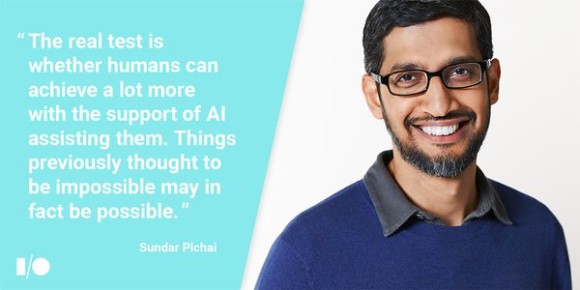
Google I/O: The machines are learning
I always look forward to Google’s I/O conference to see where the future of technology and innovation is headed and today, once again, didn’t disappoint.
This was the 10th I/O conference for Google. This is where Google shares what it’s working on so developers know where the platform is headed… and what they see as the future of technology.
 The theme of this year’s conference could not have been more clear. Artificial Intelligence (AI) was definitely the theme of this year’s conference. Whether it was their new device Google Home, their new apps Allo and Duo or their new Virtual Reality (VR) device, the future belongs to AI and machine learning.
The theme of this year’s conference could not have been more clear. Artificial Intelligence (AI) was definitely the theme of this year’s conference. Whether it was their new device Google Home, their new apps Allo and Duo or their new Virtual Reality (VR) device, the future belongs to AI and machine learning.
Machine Learning, or where machines teach themselves, to me, has the greatest impact on education. The idea that a student could soon be sitting at home and simply ask their Google Home device “How do I solve this problem?†and instead of the device giving the answer, it talks the student through how to solve the problem. It will ask the student questions, respond to those questions and actually teach the student. Now….yes….this is what parents do (and should do) and I’m not saying I want students talking to computers all the time. But it does open up some interesting possibilities for the future.
As usual, it’s the stats that get me really thinking about how we in education will continue to evolve.
300 million people were online when Google was founded.
3 Billion people are connected via mobile today.
Think about these numbers.
When you think that roughly half the world’s population is connected via a mobile device, you can’t help but think what that means for education on a global scale.
Or, what that means for your students and their ability to connect with people from…well….anywhere. What are we doing in schools and classrooms to better understand that we need to be on mobile devices? Really grasping that these devices are where people spend the majority of their time.
Over 20% of Google search queries in the US are done by voice.
Over 50% of all search queries are done on mobile devices (both stats from this year’s keynote).
Take one second and ask yourself, how does this change your classroom?
Now, figure this layer: Google states that they translate over 100 languages and over a billion words a day. Many world language teachers are still frustrated with this technology. Is it perfect?
No. But it’s getting better…every day….and every time you use it.
It’s not going away. And it has forever changed languages globally.
So, how do we embrace this new technology and make it part of our teaching? Where do we use it? When do we allow students to practice with it? When do we discuss where it’s useful and when it fails?

What a great quote from today’s Keynote:
What if we can achieve a lot more in education with technology assisting us than we previously thought possible?
What if it changes the way learning happens? What if we had to rethink teaching and learning because these technologies exist today?
We need to understand in education that the world is adopting and adapting to these new realities. How are we doing? Are we taking time to step back and think bigger than this assignment or that activity to truly consider what is happening in our phones today?
We might not like it, but we live in our phones. Not just us…everyone! Students, parents, our community at large, everyone lives in their phones. Once we accept that, then we start to harness these devices to:
- Remind students about upcoming school work and events
- Engage parents in students lives
- Inform parents about what is happening in the classroom
- Engage and inform our communities about the work that educators are doing
If we are not in their phones, they aren’t hearing us.
Often I have conversations with schools about their new website and the thousands of dollars they spend in making it easy for people to navigate through it.
What I rarely see is a school website that truly engages people in the conversation of education, that connects the school community in social conversations that lead to deep links back to the website.
People don’t “go to websites they go to web pages…that they click on from a social update. If your website does not include social, you are not engaging your community and, in fact, I would argue, you are disconnected from it.
In the end, what today’s announcements meant are nothing more than we continue to march forward into an unknown future and breaking barriers faster than we ever thought we would.
In our lifetime we’ll see electric cars, self-driving cars, and even flying cars become mainstream. Things that were only seen on the Jetsons years ago. That is what we’ll see in our future.
But what about our students? What will they see?
- The only phone they know is a smartphone.
- The only car they will drive will drive itself.
- And the only jobs that will be available are ones where people are working with computers or machines in harmony.
Their world only gets more connected from here.
And we need to prepare them for that future.
Not our past.
This post is cross-posted on the Eduro Learning Blog







We can harness the use of phones to post reminders to students, and engage parents and communities. We can deliver learning tasks through cell phones – when students are busy on their phones in class they could actually be using their devices for learning.